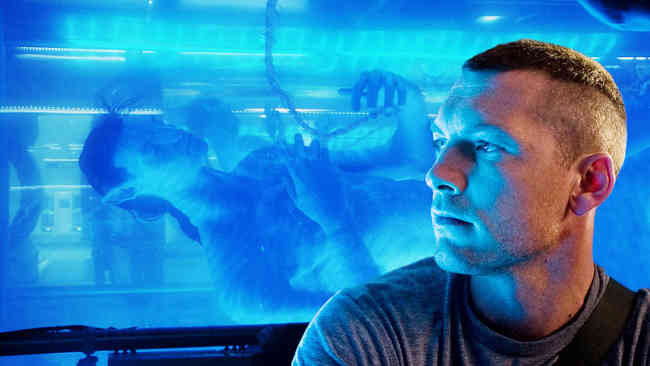Avatar’s Colonial Pitch: Revisiting Digital 3D and Platform Consciousness
In “Avatar as Technological Tentpole,” Charles Acland uses the marketing of James Cameron’s 2009 sci-fi adventure to suggest that film viewers exhibit platform consciousness, or an appreciation for the differences between a film’s exhibition formats. He also explores the ways in which Avatar was touted as a benchmark film due to its innovative use of digital 3D exhibition. With sequels on the horizon, a full-blown trilogy of follow-ups due to begin their roll-out in December of 2017 (Lang), these ideas are well worth revisiting.
Acland points to some similarities between Avatar’s purported technological newness and the film’s narrative, identifying self-reflexivity in the myriad pieces of new technology within Avatar’s diegesis. I wish to elaborate on this point and remark that Avatar goes far beyond this in thematizing its own claim of enhanced cinematic immersion via 3D, while also proposing that it does so by offering reassurance with a thoroughly conservative narrative. Says Acland, “the language of ‘game changing’ is another way to talk about business as usual.”
First, it is significant that Avatar’s central narrative concerns the literal immersion of a human subject into a new world. Jake Sully (Sam Worthington) is hired to participate in the avatar program on the alien planet Pandora. A hybrid clone made from the DNA of both a human and one of Pandora’s indigenous people, the Na’vi, the avatar is a vehicle for Jake to act as ambassador for a corporation looking to extract rare and valuable “unoptainium” from the planet. Because the precious metal is buried beneath Na’vi villages and sacred spiritual sites, Jake’s mission is in fact to obtain information that will either entice the Na’vi to relocate or be used as a weapon to force their hand. Gaining the Na’vi’s trust and becoming one of them, Jake turns his back on his human employers, joining forces with the Na’vi to help them fight their unfamiliar foe. In the language of colonialism, Jake “goes Native.”
Jake’s transportation into a new body is achieved through new technology, but more importantly, this technology allows for a wholly immersive experience and a quite literal oneness with the Na’vi. Just as the audience is treated to a three-dimensional, immersive experience of the fictional Pandora, Jake has an embodied experience of the planet and tribe via his avatar. And the fact that he is wheel-chair bound should not be ignored. Jake is aligned with the seated, generally immobile film viewer before his transportation into the avatar. His human, pre-immersed state and his avatar experience are quite directly analogous to our own pre-movie, pre-3D transition into spectatorship.
But this thematization goes further. The industrial context of Avatar and the rise of digital 3D are important. While Avatar was an early success in the 3D renaissance of the late 2000s, it was also a part of the transition to digital projection. This transition, as is well documented, occurred remarkably quickly. By the end of 2000, only 30 of the world’s theatre screens were equipped with digital projectors. This number rose exponentially, reaching 848 by 2005. Five years later, it had hit 36,103, or roughly 30% of all screens worldwide (Bordwell, 3). The universal transition is now almost complete. In 2013, 80% of the world’s films were projected digitally (Theatrical Market Statistics, 6), with 16% being screened in digital 3D (9). While 3D appears to have plateaued, we can still certainly point to Avatar as a “game changer” or at least as one rather major part of the game change.
While the shift to 3D has not been nearly as overwhelming as the digital projection revolution, the two are undoubtedly connected. In 2012, Michael Belton suggested that 3D was simply a way for digital projection to gain mass appeal with audiences. Unlike the coming of sound, colour, and widescreen, digital projection lacked any kind of visible novelty that would make the investment (and raised ticket prices) worth the risk (190). Years earlier, this premise was put forward by none other than James Cameron, along with other Hollywood heavyweights, including George Lucas, Robert Zemeckis, and Peter Jackson at the 2005 ShoWest convention in Las Vegas (now CinemaCon). There, these filmmakers, addressing a throng of American exhibitors, looked to convince their audience to convert to digital projection. In order to do so, they presented digital 3D as the “killer app” to sell digital to moviegoers (Bordwell 65). Cameron promised Battle Angel, while Lucas proposed a 3D re-release of Star Wars (1977), Zemeckis mentioned two upcoming 3D projects, and Jackson looked forward “to one day seeing Hobbits in 3D” (66). While Battle Angel was replaced by Avatar, the whole group made good on their word, and digital broke through.
Thomas Elsaesser adds that 3D is nothing new. Having failed in the 1950s, he proposes that its star will quickly fade again (219). While he may be underestimating the lasting power of 3D, Elsaesser does bring up one of the ironies of Hollywood innovation. In order to progress, the film industry has a history of maintaining a conservative stance wherever possible:
…very few of [Hollywood’s] industrial and business innovations have actually been noted by the average viewer because so much in our movie-going experience has remained the same: the two-hour feature film, the narrative format, the genres-and-stars formula, the racked seating, the projector position, the social habit of going to the movies, and the popcorn and the soft drinks (226).
3D especially conforms to a need to reel in even the industrial novelties that transform the medium; it is yesteryear’s novelty, dubiously passed off as something new and exciting once again.
In this regard, Avatar is an all too fitting symbol of the rebirth of 3D and the coming of digital projection. To return to my earlier point, Avatar thematizes far more than the immersive qualities of 3D cinema. It allegorizes the conservative safety of Hollywood in its colonial narrative of racial transcendence. Like digital projection, Jake functions as a bridge between two worlds. He represents the world of humans and the tremendous sovereignty that such a society has afforded him by way of his avatar. He also represents a threat. The Na’vi, portrayed as a peaceful race, are a proxy for Hollywood’s romanticization of Native Americans, frozen in a fictional past. As much as Jake represents a kind of western “progress,” he also brings with him an imperialist war machine. A force that threatens the Na’vi way of life - if not their entire existence.
Progress must upset the status quo by its very nature, and the Na’vi recognize the very real threat posed not only by humans but by Jake specifically. He is a mercenary, representing both corporate greed and the military industrial complex of humanity. But by becoming a member of the Na’vi, by becoming familiar, he instead functions as an ally and savior. Eventually, Jake absurdly becomes more Na’vi than the Na’vi, taming the largest of their winged steed to become “Turuk Macto,” a rare position of authority that empowers him to unite the Na’vi tribes. He also communicates with the Na’vi nature goddess Eywa in a way that seems far more direct than any communion experienced by genuine Na’vi characters.
As an allegory meant to convince us that 3D, and by extension digital projection, can be safe and familiar, this is quite effective. Avatar is not a new narrative. The reassurance of the platform conscious viewer comes in the form of a story that fits neatly into literary and film history. Jake is Lieutenant Dunbar in Dances with Wolves (1990). He is John Smith in Disney’s Pocahontas (1995). He is Nathan Algren in The Last Samurai (2003). Cameron has crafted a narrative with very little to disrupt the storytelling traditions of Hollywood, making his industrially revolutionary - and deeply disruptive - film palatable for audiences and industry insiders alike. The film, in short, paves the way for itself narratively.
Effectively, Cameron assures us that new projection technology will only be used to deliver the same old Hollywood we’ve grown accustomed to. Digital projection has to prove itself worthy, like Jake. It must demonstrate a knowledge of the traditions and language of cinema. But once it has done so, it answers to no one. It takes on a role of leadership. By masquerading as that which was once projected on celluloid (much as, in Acland’s words, Jake performs in “blueface”) this digital artifact claims authority over the tribe of cinema. Perhaps a celluloid purist would read more into the metaphorical implications of Jake’s colonial arrogance than I will here.
Avatar is not alone in its thematizing of technological progress. This discussion could quite easily be applied to the narrative of novelty and state-of-the-art computer graphics of Jurassic Park (1992). Similarly, Netlfix’s inaugural “original series,” House of Cards features a reporter proving the superiority of online news over print media, while the series itself purportedly provides an unprecedented alternative to traditional broadcast. Steven Shaviro has written about other examples like Gamer (2009) and Southland Tales (2006) on his blog and in his book Post-Cinematc Affect. Though less about thematizing their own novelty, these films tend to thematize the contemporary, ubiquitous hypermediation that they take part in.
While cinema can comment and reflect upon society, it is just as adept at looking inward and reflecting its own industrial status, whether progressive or not. In Avatar’s case, one has to wonder at the politics of colonialism being interpolated as a subliminal selling point, a mark of industrial distinction, a tool for game changing.
Works Cited
- Acland, Charles R. “Avatar as Technological Tentpole.” Flow TV 11.6 (2010). Web.
- Belton, John. “Digital 3D Cinema: Digital Cinema’s Missing Novelty Phase.” Film History: An International Journal 24.2 (2012): 187-195. Print.
- Bordwell, David. Pandora’s Digital Box: Films, Files, and the Future of Movies. Madison, Wisconsin: The Irvington Way Institute Press, 2012. Ebook.
- Elsaesser, Thomas. “The ‘Return’ of 3-D: On Some of the Logics and Genealogies of the Image in the Twenty-First Century.” Critical Inquiry 39.2 (2013): 217-246.
- Lang, Brent. “James Cameron Pushes Back ‘Avatar’ Sequels by a Year.” Variety Online, 2015. Web.
- Shaviro, Steven. Post-Cinematic Affect. Washington: Zero Books, 2010. Print.
- Theatrical Market Statistics 2013. Motion Picture Association of America, Inc., 2013. Web.


